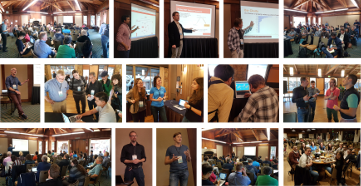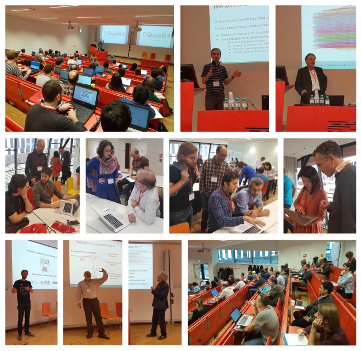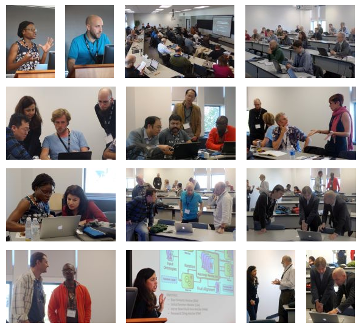Visualization and Interaction for Ontologies and Linked Data
2nd International Workshop co-located with ISWC 2016, October 17, 2016, Kobe, Japan

Announcement: VOILA 2019
VOILA! will take place again at ISWC 2019. Details can be found on the VOILA 2019 workshop website.
Motivation and Objectives
'A picture is worth a thousand words', we often say, yet many areas are in demand of sophisticated visualization techniques, and the Semantic Web is not an exception. The size and complexity of ontologies and Linked Data in the Semantic Web constantly grows and the diverse backgrounds of the users and application areas multiply at the same time. Providing users with visual representations and intuitive interaction techniques can significantly aid the exploration and understanding of the domains and knowledge represented by ontologies and Linked Data.
Ontology visualization is not a new topic and a number of approaches have become available in recent years, with some being already well-established, particularly in the field of ontology modeling. In other areas of ontology engineering, such as ontology alignment and debugging, although several tools have recently been developed, few provide a graphical user interface, not to mention navigational aids or comprehensive visualization and interaction techniques.
In the presence of a huge network of interconnected resources, one of the challenges faced by the Linked Data community is the visualization of multidimensional datasets to provide for efficient overview, exploration and querying tasks, to mention just a few. With the focus shifting from a Web of Documents to a Web of Data, changes in the interaction paradigms are in demand as well. Novel approaches also need to take into consideration the technological challenges and opportunities given by new interaction contexts, ranging from mobile, touch, and gesture interaction to visualizations on large displays, and encompassing highly responsive web applications.
There is no one-size-fits-all solution but different use cases demand different visualization and interaction techniques. Ultimately, providing better user interfaces, visual representations and interaction techniques will foster user engagement and likely lead to higher quality results in different applications employing ontologies and proliferate the consumption of Linked Data.
Program
The workshop will take place at Kobe Convention Center, room 503 (5th floor).
9:00 - 9:15 Opening
9:15 - 10:30 Session I: Visualization of Domain Ontologies and Data
9:15 - 9:30 VIZ-VIVO: Towards Visualizations-driven Linked Data Navigation
(Muhammad Javed, Sandy Payette, Jim Blake and Tim Worrall)
9:30 - 9:45 PrEVIEw: Clustering and Visualizing PubMed using Visual Interface
(Syeda Sana E Zainab, Qaiser Mehmood, Durre Zehra, Dietrich Rebholz-Schuhmann and Ali Hasnain)
9:45 - 10:00 A Linked Data Driven Visual Interface for the Multi-perspective Exploration of Data Across Repositories
(Gengchen Mai, Krzysztof Janowicz, Yingjie Hu and Grant McKenzie)
10:00 - 10:10 Exploring Visualization of Geospatial Ontologies using Cesium
(Abhishek Potnis and Surya Durbha)
until 10:30 Wrap Up & Discussion
10:30-11:00 Coffee Break
11:00 - 12:30 Session II: Visualization in Ontology Engineering
11:00 - 11:10 Starting Ontology Development by Visually Modeling an Example Situation - A User Study
(Marek Dudáš, Vojtěch Svátek, Miroslav Vacura and Ondřej Zamazal)
11:10 - 11:20 Advanced UML Style Visualization of OWL Ontologies
(Jūlija Ovčiņņikova and Kārlis Čerāns)
11:20 - 11:35 Extending Ontology Visualization with Interactive Contextual Verbalization
(Uldis Bojārs, Renārs Liepiņš, Normunds Grūzītis, Kārlis Čerāns and Edgars Celms)
11:35 - 11:50 Visualizing User Editing Behavior in Collaborative Ontology-engineering Projects
(Simon Walk, Tania Tudorache and Mark Musen)
11:50 - 12:05 Visualization for Ontology Evolution
(Patrick Lambrix, Zlatan Dragisic, Valentina Ivanova and Craig Anslow)
until 12:30 Wrap Up & Discussion
12:30 - 14:00 Lunch
14:00 - 15:15 Session III: Visualization of SPARQL Queries and Endpoints
14:00 - 14:15 A Visual Aide for Understanding Endpoint Data
(Fernando Florenzano, Denis Parra, Juan L. Reutter and Freddie Venegas)
14:15 - 14:25 LD-VOWL: Extracting and Visualizing Schema Information for Linked Data Endpoints
(Marc Weise, Steffen Lohmann and Florian Haag)
14:25 - 14:35 ViziQuer: Notation and Tool for Data Analysis SPARQL Queries
(Kārlis Čerāns and Jūlija Ovčiņņikova)
14:35 - 14:50 SQuaRE: A Visual Support for OBDA Approach
(Michał Blinkiewicz and Jarosław Bąk)
until 15:15 Wrap Up & Discussion
15:15 - 15:30 Demo Session (Stand-up)
15:30 - 16:00 Coffee Break
16:00 - 16:30 Demo Session (Break-out)
16:30 - 17:15 Session IV: Visualization in Semantic Annotation
16:30 - 16:45 Semantic Annotation and Information Visualization for Blogposts with refer
(Tabea Tietz, Joscha Jäger, Jörg Waitelonis and Harald Sack)
16:45 - 16:55 Visual Development & Analysis of Coreference Resolution Systems with CORVIDAE
(Nico Möller and Gunther Heidemann)
until 17:15 Wrap Up & Discussion
17:15 - 17:30 Closing
Impressions
About 40 researchers and practitioners took part in the full-day event consisting of talks, discussions, and tool demonstrations. Here are some impressions from the workshop:
Proceedings
The workshop proceedings are published as CEUR-WS volume 1704.
V. Ivanova, P. Lambrix, S. Lohmann, C. Pesquita: Proceedings of the Second International Workshop on Visualization and Interaction for Ontologies and Linked Data (VOILA '16), Kobe, Japan. CEUR Workshop Proceedings, vol. 1704, CEUR-WS.org, 2016.
Topics of Interest
Topics, subjects, and contexts of interest include (but are not limited to):
- Topics:
- visualizations
- user interfaces
- visual analytics
- requirements analysis
- case studies
- user evaluations
- cognitive aspects
- Subjects:
- ontologies
- linked data
- ontology engineering (development, collaboration, ontology design patterns, alignment, debugging, evolution, provenance, etc.)
- Contexts:
- classical interaction contexts (desktop, keyboard, mouse, etc.)
- novel interaction contexts (mobile, touch, gesture, etc.)
- special settings (large, high-resolution, and multiple displays, etc.)
- specific user groups and needs (people with disabilities, domain experts, etc.)
Submission Guidelines
Paper submission and reviewing for this workshop will be electronic via EasyChair. The papers should be written in English, following the Springer LNCS format, and be submitted in PDF on or before July 7, 2016 (Hawaii time).
The following types of contributions are welcome. The recommended page length is given in brackets. There is no strict page limit but the length of a paper should be commensurate with its contribution.
- Full research papers (8-12 pages);
- Experience papers (8-12 pages);
- Position papers (6-8 pages);
- Short research papers (4-6 pages);
- System papers (4-6 pages).
Accepted papers will be published as a volume in the CEUR Workshop Proceedings series. See CEUR-WS volume 1456 for the proceedings of last year's VOILA workshop.
Note that workshop attendees cannot register for the workshop only, but need to register for the main conference, as well.
Special Issue in JWS
We are preparing a special issue on the workshop topic for the top-ranked Journal of Web Semantics. More details on the special issue are given in the call for papers.
Organizers
Patrick Lambrix, Linköping University, Sweden
Steffen Lohmann, Fraunhofer IAIS, Germany
Catia Pesquita, University of Lisbon, Portugal
Programme Committee
Isabel F. Cruz, University of Illinois at Chicago, USA
Aba-Sah Dadzie, Knowledge Media Institute, The Open University, UK
Roberto García, Universitat de Lleida, Spain
Anika Gross, University of Leipzig, Germany
Willem Robert van Hage, Netherlands eScience Center, The Netherlands
Ali Hasnain, The Insight Centre for Data Analytics, Ireland
Eero Hyvönen, Aalto University & University of Helsinki, Finland
Hanmin Jung, Korea Institute of Science and Technology Information, Korea
Tomi Kauppinen, Aalto University School of Science, Finland
Ali Khalili, Vrije Universiteit Amsterdam, The Netherlands
Suvodeep Mazumdar, University of Sheffield, UK
Paul Mulholland, Knowledge Media Institute, The Open University, UK
Stefan Negru, MSD IT Global Innovation Center, Czech Republic
Francesco Osborne, Knowledge Media Institute, The Open University, UK
Heiko Paulheim, University of Mannheim, Germany
Silvio Peroni, University of Bologna & CNR-ISTC, Italy
Emmanuel Pietriga, INRIA Saclay, France
Harald Sack, Hasso Plattner Institute, University of Potsdam, Germany
Daniel Schwabe, Pontifical Catholic University of Rio de Janeiro, Brazil
Gem Stapleton, University of Brighton, UK
Vojtěch Svátek, University of Economics, Prague, Czech Republic
Important Dates
Abstracts: July 7, 2016Submission: July 7, 2016Notification: August 3, 2016Camera-ready: August 15, 2016Workshop: October 17, 2016






